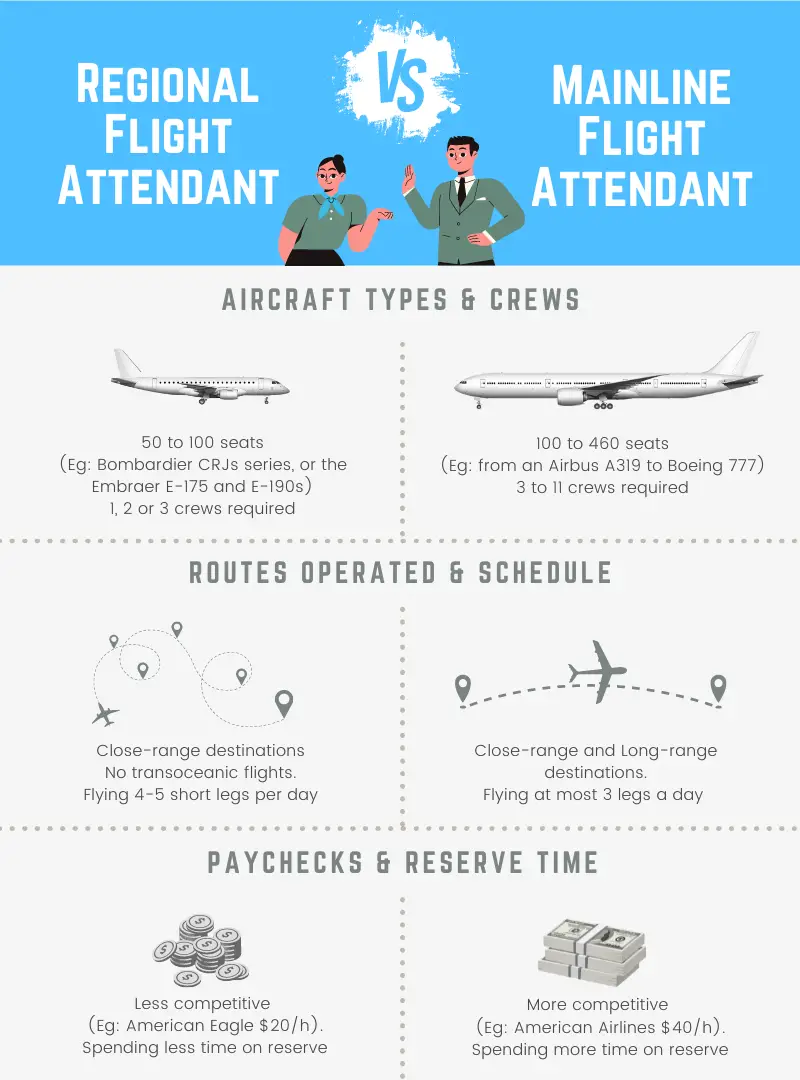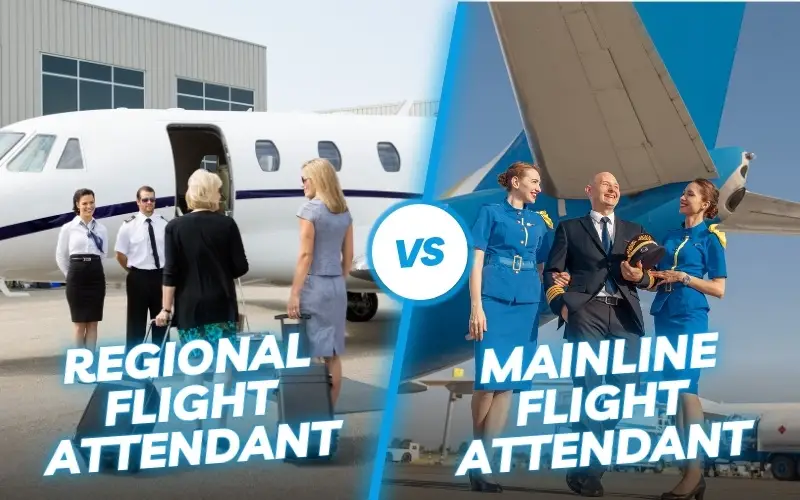What are the differences between regional and mainline airlines, and how do these differences manifest when it comes to working as a flight attendant?
As a former flight attendant for American Airlines with numerous friends at its regional subsidiary, American Eagle, I am well-equipped to guide you through these distinctions.
💡 Key Takeways
- Aircraft & Routes: Regional airlines use smaller planes for shorter routes, unlike mainline airlines.
- Schedule: Regional attendants have longer duty days but less flight hours.
- Pay: Mainline attendants earn more than regional attendants.
- Reserve Time: Regional attendants have shorter reserve times due to fast seniority.
- Career: Regional airlines offer fast progression, while mainline offers higher pay and benefits.
Let’s begin with an infographic that captures the core differences at a glance. Afterward, we will delve into the nitty-gritty of these contrasts.

Aircraft Types
Regional airlines fly primarily smaller aircraft, like the Bombardier CRJs series, or the Embraer E-175 and E-190s.
These airplanes seat between 50 and 100 people.
Compared to mainline aircrafts that tend to include everything from an Airbus A319 at the smallest, seating 100 people, and the Airbus A380 at the largest, seating up to 460 people (depending on the airline’s chosen configuration).
Regional flight attendants tend to only need to learn how to operate fewer aircrafts than their mainline compatriots.
American Eagle flight attendants, for example only learn to operate 3 aircrafts, whereas at American mainline I was trained on 11 aircraft types.
Routes Operated
Because the regional jets tend to be smaller, they also cannot fly as far, which limits which routes can be operated by regional airlines.
Contrary to popular belief regional carriers do operate international flights.
In the US you can usually fly regional to Canada or Mexico, depending on your origin airport, but transoceanic flights are reserved for mainline carriers.
In Europe, regional carriers regularly fly between close-range European cities. But that’s really a matter of the geography in Europe.
Schedule
One of the main differences between the life of a regional and a mainline flight attendant is the schedule.
Because regional airlines operate shorter flights, regional flight attendants will operate more flights (“legs”) per day than a mainline flight attendant.
On average regional flight attendants will fly 4-5 short legs, while a mainline flight attendant will fly at most 3 legs a day (baring irregular schedules).
Thus, regional flight attendants will tend to have longer duty days with fewer flight hours, because so much of their day is spent boarding and deplaning.
Paychecks
Since flight hours (not duty day) determines how a flight attendant is paid, regional flight attendants tend to be paid less than mainline flight attendants.
This is compounded by the fact that the pay scale for regional airlines tends to be less competitive compared to their mainline partners.
For example, the average hourly flight pay for American Eagle is $20, while the average at American mainline is $48.
Reserve Time
Depending on how you feel about reserve, the one major benefit that comes with working for a regional airline is the fact that you will, on average, spend less time on reserve than a mainline flight attendant will.
This is mainly because seniority moves fast.
At regionals, since most people only stay with regionals for a few years to get the experience they need on the resume to transition up to a mainline career.
Whereas mainline flight attendants can expect to serve reserve in some capacity for 15 years or more, depending on which airline they work for.
At American Eagle, for example, a few friends of mine were more-or-less done with reserve after their second year, whereas at American mainline, people with 30 years of seniority still have to be on reserve once or twice a year.
Bases
The regional airlines tend to have bases in the same places as the mainline airlines in the US.
In Europe regional carriers, especially the budget regional carriers, tend to have bases in secondary cities.
For example, Munich is a base for Lufthansa, and Lufthansa City Line, but Ryanair, which could be considered a large regional carrier, has bases in Nuremberg instead.
Overnights/Destinations
As mentioned above, most regional airlines do not operate transoceanic flights, but may still fly to international destinations, so there are still opportunities to explore foreign cities on layovers as a regional flight attendant.
But if you hope to fly the NYC-Paris route and enjoy Parisian overnights, you’d best opt for a mainline carrier.
That said, regional flight attendants will have a better opportunity to explore the often charmingly underrated second-tier cities or their areas.
I remember being a little jealous of a friend who worked for American Eagle who got 24-hour layovers in Asheville, North Carolina, when I would never fly there myself (for work).
Crews
The crews at regional also tend to be smaller, on account of the smaller aircraft types.
For example, if you fly the CRJ-200 for American Eagle, that carriers only 50 people, you will be working by yourself: a crew of you alone. The largest crew is a crew of 2 or 3 on the E-190.
Whereas the smallest crew possible at American mainline is 3 flight attendants on the A319 and A320 and the largest crew you might work with is 11 people on the Boeing 777.
In Flight Service
The inflight service you will perform is also very different.
Regional airlines tend to only perform a simple beverage service with a small complementary snack. That means you won’t be serving three-course meals on any of your flights.
Mainline flight attendants are expected to be able to serve anything from a quick beverage service to multiple multi-course meal services.
The Pilots
The pilots are different too. Most regional pilots are young.
Like I used to find them shockingly young when I would non-rev on an American Eagle flight.
More often than not I was older than them and I quit before turning 28…
Meanwhile, mainline pilots tend to be old. The young guys transition up around their late twenties and are stuck flying as first officers on the smaller aircrafts for a while, so mostly you end up working with pilots who could be the same age as your parents.
If you are wanting to catch pilot SO, regional is the way to go.
If you want a pilot to platonically buy you dinner and drinks on your overnight, go for mainline.
Conclusion
There are benefits to working for regional airlines, if you want to fly but need to move through the ranks quickly so you have more control over your schedule, for example, regional might be your best option.
But honestly… Go for a mainline.


